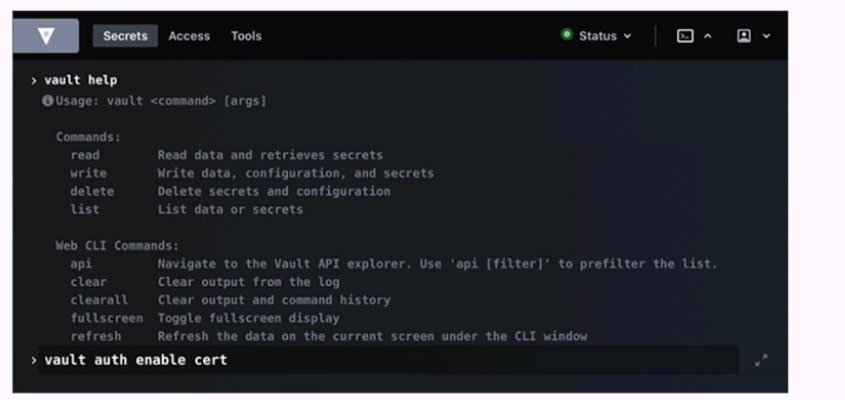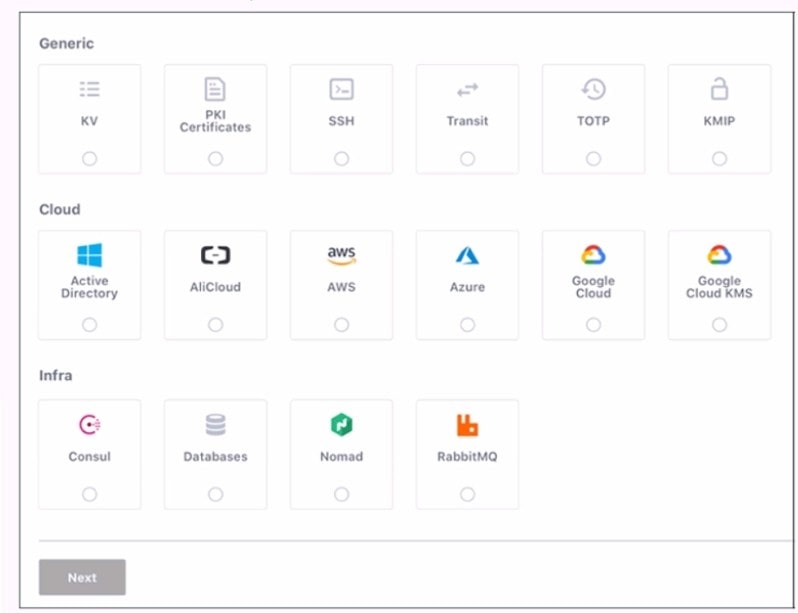VAULT-ASSOCIATE Online Practice Questions and Answers
The Vault encryption key is stored in Vault's backend storage.
A. True
B. False
An authentication method should be selected for a use case based on:
A. The auth method that best establishes the identity of the client
B. The cloud provider for which the client is located on
C. The strongest available cryptographic hash for the use case
D. Compatibility with the secret engine which is to be used
Which of the following statements are true about Vault policies? Choose two correct answers.
A. The default policy can not be modified
B. You must use YAML to define policies
C. Policies provide a declarative way to grant or forbid access to certain paths and operations in Vault
D. Vault must be restarted in order for a policy change to take an effect
E. Policies deny by default (empty policy grants no permission)
Running the second command in the GUI CLI will succeed.

A. True
B. False
What does the following policy do?

A. Grants access for each user to a KV folder which shares their id
B. Grants access to a special system entity folder
C. Allows a user to read data about the secret endpoint identity
D. Nothing, this is not a valid policy
Examine the command below. Output has been trimmed.

Which of the following statements describe the command and its output?
A. Missing a default token policy
B. Generated token's TTL is 60 hours
C. Generated token is an orphan token which can be renewed indefinitely
D. Configures the AppRole auth method with user specified role ID and secret ID
Where does the Vault Agent store its cache?
A. In a file encrypted using the Vault transit secret engine
B. In the Vault key/value store
C. In an unencrypted file
D. In memory
You have a 2GB Base64 binary large object (blob) that needs to be encrypted. Which of the following best describes the transit secrets engine?
A. A data key encrypts the blob locally, and the same key decrypts the blob locally.
B. To process such a large blob. Vault will temporarily store it in the storage backend.
C. Vault will store the blob permanently. Be sure to run Vault on a compute optimized machine
D. The transit engine is not a good solution for binaries of this size.
You can build a high availability Vault cluster with any storage backend.
A. True
B. False
You are performing a high number of authentications in a short amount of time. You're experiencing slow throughput for token generation. How would you solve this problem?
A. Increase the time-to-live on service tokens
B. Implement batch tokens
C. Establish a rate limit quota
D. Reduce the number of policies attached to the tokens
Which of the following is a machine-oriented Vault authentication backend?
A. Okta
B. AppRole
C. Transit
D. GitHub
The key/value v2 secrets engine is enabled at secret/ See the following policy:

Which of the following operations are permitted by this policy? Choose two correct answers.
A. vault kv get secret/webapp1
B. vault kv put secret/webapp1 apikey-"ABCDEFGHI] K123M"
C. vault kv metadata get secret/webapp1
D. vault kv delete secret/super-secret
E. vault kv list secret/super-secret
Which of the following vault lease operations uses a lease_id as an argument? Choose two correct answers.
A. renew
B. revoke -prefix
C. create
D. describe
E. revoke
Which of the following are replication methods available in Vault Enterprise? Choose two correct answers.
A. Cluster sharding
B. Namespaces
C. Performance Replication
D. Disaster Recovery Replication
Use this screenshot to answer the question below: When are you shown these options in the GUI?

A. Enabling policies
B. Enabling authentication engines
C. Enabling secret engines
D. Enabling authentication methods
